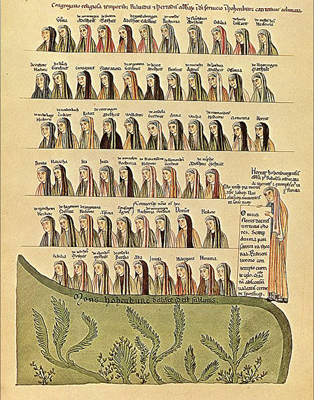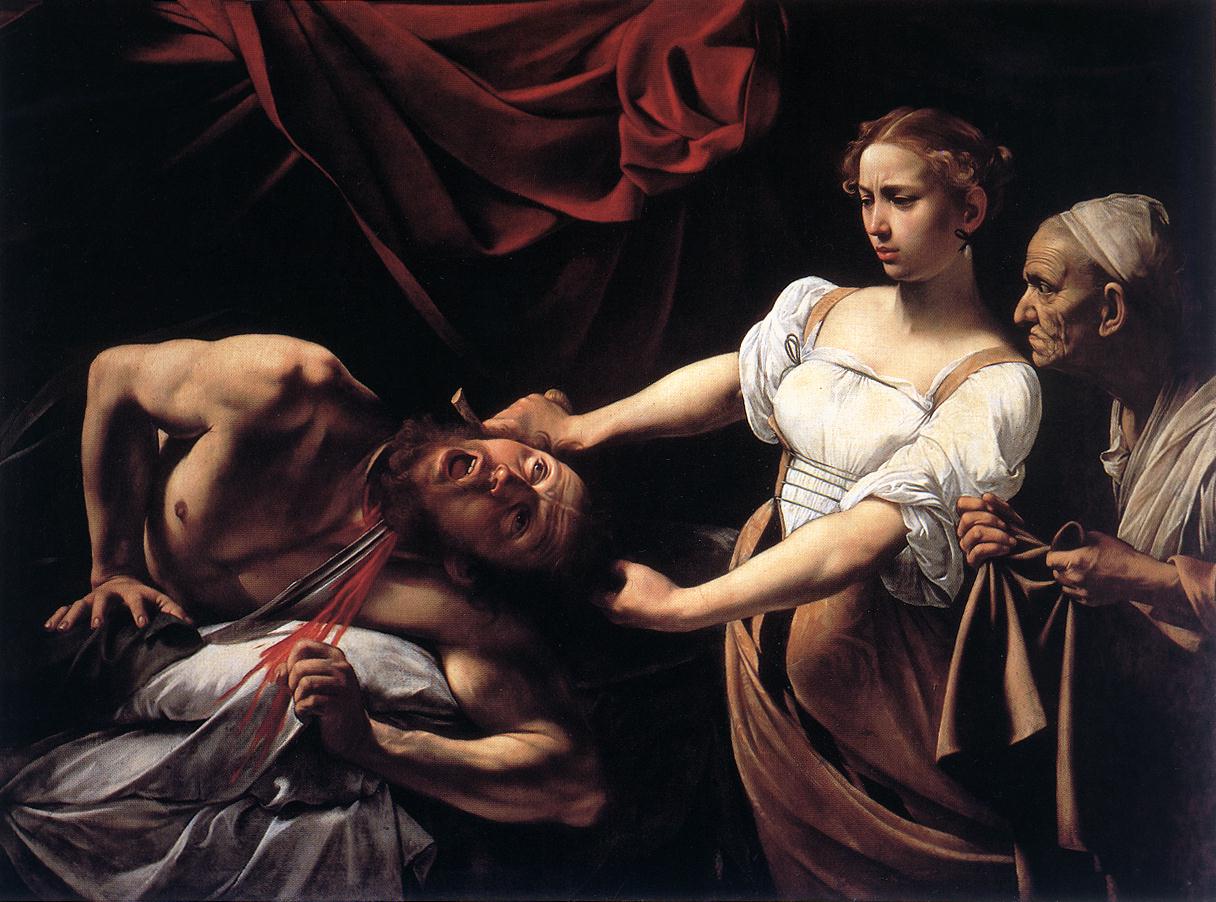 |
| Hortus Deliciarum by Herrad of Landsberg |
Nuns in the Middle Ages had an upper-hand at doing things that other women in their time were not able to do since nuns took up their time in the monasteries and the monasteries were the central power. Besides getting educated, some nuns such as Hildegard von Bingen, wrote illustrated manuscripts of divine messages and others made tapestries. Hortus Deliciarum (Gardens of Delight) was a medieval manuscript that was put together by Herrad of Landsberg to "praise the Christ and the Church," (Chadwick 56). In this manuscript, Herrad of Landsberg dedicated a page of all the sisters that were with her in the convent with their names written Latin or German. As the Enlightenment and the Renaissance started to come about, people began to think for themselves.
 |
| Original by Caravaggio |
 |
| Remake by Artemisia |
During the 17th and 18th century, nude paintings came back into style but, men were only allowed to do learn nude paintings. The Netherlands were growing wealthy and people wanted to show off their materialistic possessions. As for the women painters in that period, they had started exploring other areas of painting such as still life, paintings of flowers and insects, and the growing popularity of portraiture. Judith Leyster was famous for her scenic paintings and some portrait paintings. She was apprenticed to Frans Hals who was a renown Dutch painter. She went on to have three male apprentices as she was a member of the Painters' Guild. As Leyster married and had children, she had less time to paint and eventually, she died unknown. Anna Maria Sybilla Merian took interest in a new area of art. She was interested in animal and plant life and most of her paintings were based on live specimens and botanical breeds. As Merian's interest of flowers and insects grew, she and her two daughters went to Surinam to document flowers and insects. She did Metamorphosis Insectorum Surinamensium where she painted numerous amounts of insects and flowers. She died in poverty however, her daughters kept on her work.
 In the 19th century, technology was advancing, women began to fight for their rights, the movement was called, Women Suffrage, and Impressionism was becoming the new art style in paintings. The camera was invented sometime during the 19th century and Julia Margaret Cameron at the age of 48, took interest in photography. She was a lonely woman after her children got married. Cameron ended up taking photography as a hobby after one her children gave her a camera as a gift. She took photos of beautiful women and intellectual old men. According to the Guerrilla Girls, the beautiful women personified characters from poetry or myths and the old men were simply themselves (p. 52). She excelled in her photography by producing books illustrating Tennyson's Idyll's of the King and other poems which she received great reviews. Although, she discontinued taking photos after her husband and her move to Ceylon, she was part of something innovative, "a new kind of art" (Guerrilla Girls 53). From the Middle Ages throughout the 19th century, some women were lucky to enough to get educated and show their expertise in art for the fact they were either from noble families or were born into artistic family or simply because they were lucky. Others did make an impression in their artwork such as Judith Leyster and Maria Robusti but then, their work did not prosper after getting married and having kids or after their death. Then, there were even other artists who regardless of whether they got married and have kids continued to make their artwork prosper such as Artemisia Gentileschi.
In the 19th century, technology was advancing, women began to fight for their rights, the movement was called, Women Suffrage, and Impressionism was becoming the new art style in paintings. The camera was invented sometime during the 19th century and Julia Margaret Cameron at the age of 48, took interest in photography. She was a lonely woman after her children got married. Cameron ended up taking photography as a hobby after one her children gave her a camera as a gift. She took photos of beautiful women and intellectual old men. According to the Guerrilla Girls, the beautiful women personified characters from poetry or myths and the old men were simply themselves (p. 52). She excelled in her photography by producing books illustrating Tennyson's Idyll's of the King and other poems which she received great reviews. Although, she discontinued taking photos after her husband and her move to Ceylon, she was part of something innovative, "a new kind of art" (Guerrilla Girls 53). From the Middle Ages throughout the 19th century, some women were lucky to enough to get educated and show their expertise in art for the fact they were either from noble families or were born into artistic family or simply because they were lucky. Others did make an impression in their artwork such as Judith Leyster and Maria Robusti but then, their work did not prosper after getting married and having kids or after their death. Then, there were even other artists who regardless of whether they got married and have kids continued to make their artwork prosper such as Artemisia Gentileschi. Work Cited
Chadwick, Whitney. Women, Art, and Society. 3rd Edition. United Kingdom: Thames and Hudson Ltd., 1990.
Girls, Guerilla. The Guerilla Girls' Bedside Companion To The History of Western Art. England: Penguin Books., 1998
No comments:
Post a Comment